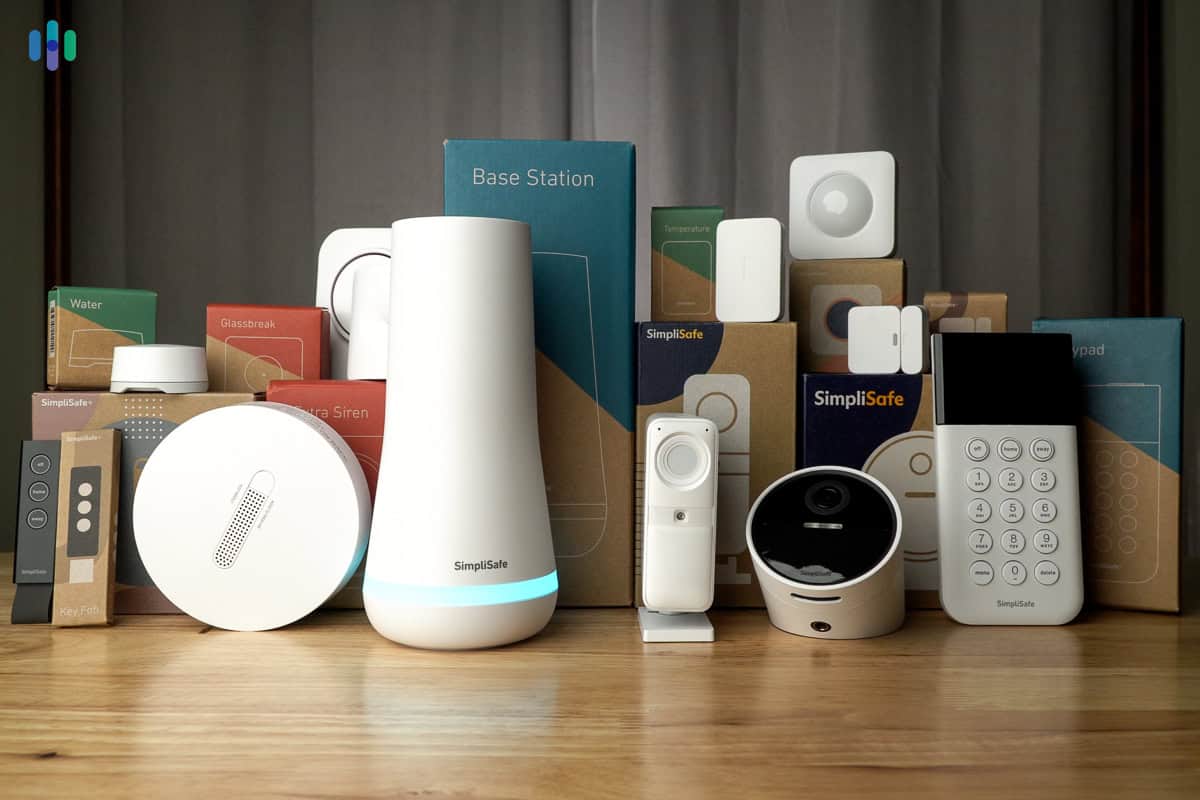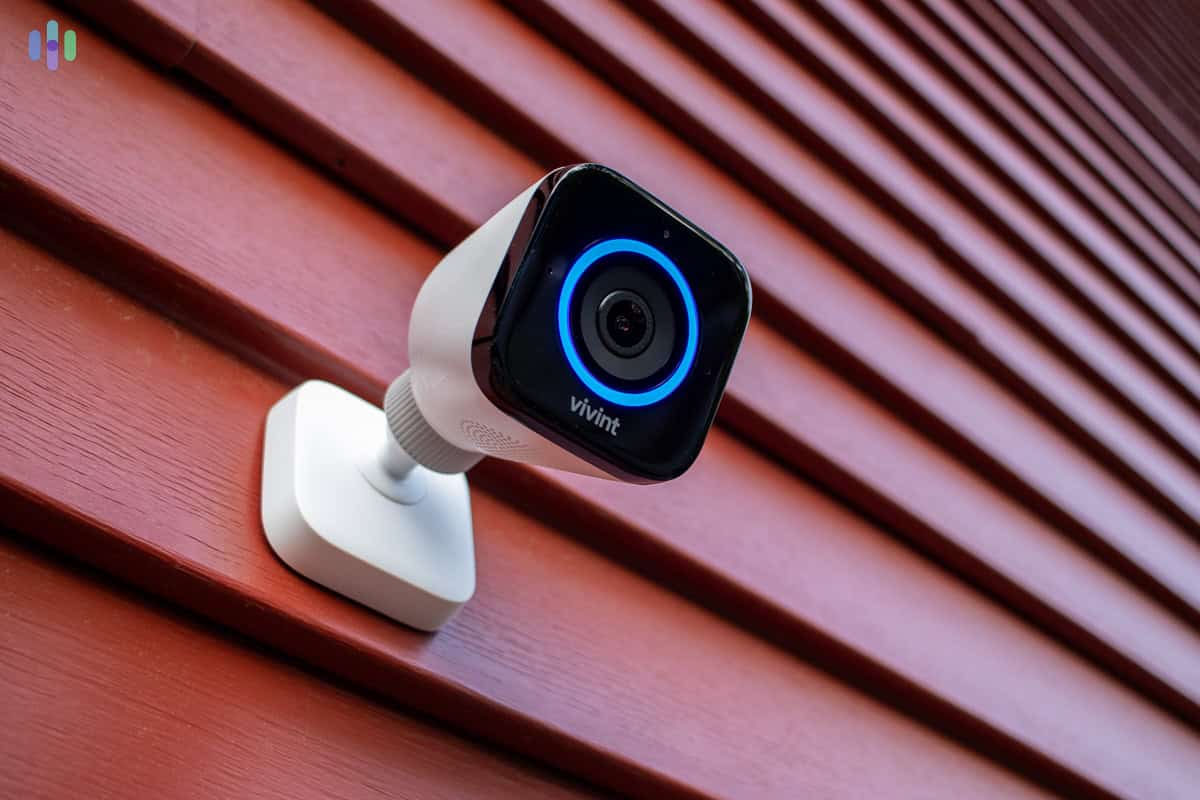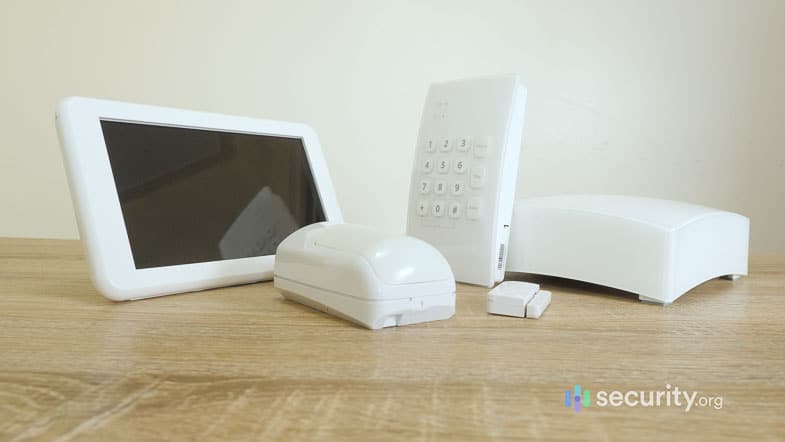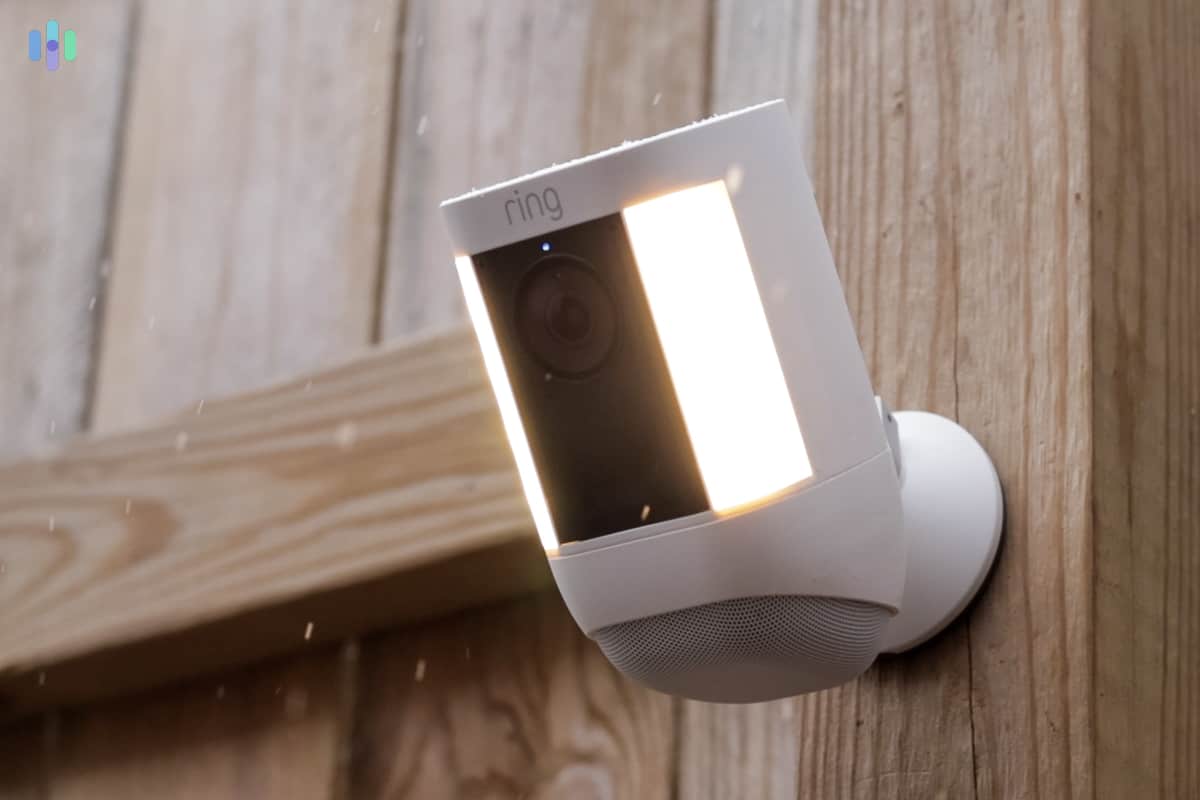Best Security Systems for Outdoor Security in 2025
Our top pick ADT lets you control your security operations with an app and get maximum coverage from professionally installed cameras.


- Professional installation means you can be sure outdoor cameras provide maximum coverage
- The ADT+ app lets you control outdoor security components from the comfort of your living room
- Cameras include advanced capabilities such as facial recognition that enables sophisticated automation
- Professional installation means you can be sure outdoor cameras provide maximum coverage
- The ADT+ app lets you control outdoor security components from the comfort of your living room
- Cameras include advanced capabilities such as facial recognition that enables sophisticated automation

- Cellular connectivity ensures a strong connection even with outdoor equipment
- Cameras are rated IP65 so they are dust-tight and can withstand water from a nozzle
- Active Guard Outdoor Protection enables monitoring agents to intervene before criminals can enter your home
- Cellular connectivity ensures a strong connection even with outdoor equipment
- Cameras are rated IP65 so they are dust-tight and can withstand water from a nozzle
- Active Guard Outdoor Protection enables monitoring agents to intervene before criminals can enter your home

- Advanced outdoor cameras and video doorbell offer automated active deterrence features using the built-in siren and light
- Video doorbell offers ultrawide 180-degree field of view both horizontally and vertically
- Vivint’s smart home security extends to your car
- Advanced outdoor cameras and video doorbell offer automated active deterrence features using the built-in siren and light
- Video doorbell offers ultrawide 180-degree field of view both horizontally and vertically
- Vivint’s smart home security extends to your car
A typical home security system includes entryway sensors, motion sensors, and maybe a few security cameras. Notice anything? Most security components focus on indoor security. Entry sensors warn you when someone opens a door or window to your house. Motion sensors detect movement… indoors. And security cameras? They’re usually used to monitor living rooms, pet crates, and nurseries.
Protecting your home from burglars means boosting your outdoor security too. Having security equipment outdoors sends a clear message that your home isn’t to be messed with. Fortunately, you don’t need a separate indoor and outdoor security system. Any one of our highest-rated security systems can protect your home inside and out. These five, in particular, stand out.
But, some security systems offer more for outdoor protection than others. It might be top-of-the-line outdoor security cameras or the way monitoring services utilize their outdoor security equipment. In particular, ADT, SimpliSafe, Vivint, Frontpoint, and Ring Alarm stood out for their advanced outdoor protections.
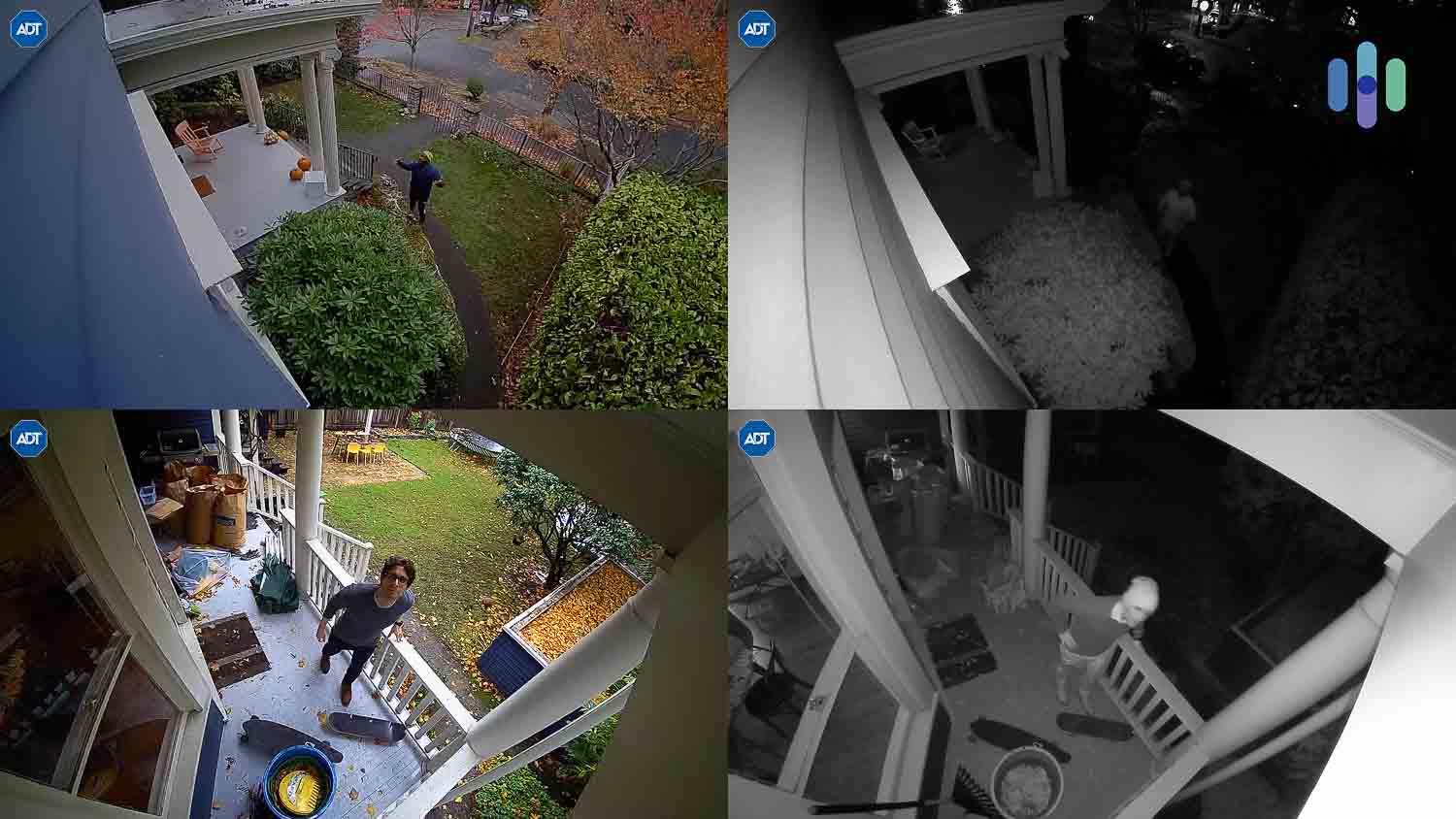
The Top Security Systems With Outdoor Security Features
- ADT - Best Professional Monitoring
- SimpliSafe - Best DIY Security System
- Vivint - Best Outdoor Cameras
- Frontpoint - Best Outdoor Cameras with 24/7 Recording
- Ring Alarm - Best Video Doorbells and Lighting-Equipped Cameras
What You Need for Outdoor Security
Regular entry sensors won’t work outdoors and there’s just too many moving things outside your house for motion sensors to be effective. So what do you need for outdoor security? Two words: Security cameras. Specifically, you need outdoor cameras to cover most outdoor spaces and a video doorbell, which are specialized for front doors. Here’s what outdoor cameras and video doorbells can do for your home security:
- Outdoor cameras: These security cameras are built so ruggedly they can stay outdoors under rain, sunlight, or snow. The best outdoor cameras are usually wireless, and they provide features such as motion-activated recordings, alerts, and the ability to stream live footage to a smartphone.
- Video doorbells: Also known as doorbell cameras, they’re a security camera, doorbell, and intercom all in one device that allows users to monitor their front doors. They are valuable for keeping porch pirates and package thieves at bay. The top doorbell cameras offer features such as person detection and package detection.
All our five top picks offer high-quality outdoor and doorbell cameras. We should know; we tested them ourselves in our 2,500-square-foot home with a pretty big front yard and a back garden facing a wooded area.
But simply having outdoor and doorbell cameras isn’t enough to warrant our recommendation. Lots of companies offer those. We have to look at other factors, like their supporting cast of security equipment and the monitoring options they offer. The pros and cons of the cameras themselves also matter a lot, and for that, our experience with each system will come handy.
Ready to learn about the best outdoor security systems? Let’s dig right in!
Overview: Specs of the Best Outdoor Security Systems
| System |
ADT


|
SimpliSafe


|
Vivint

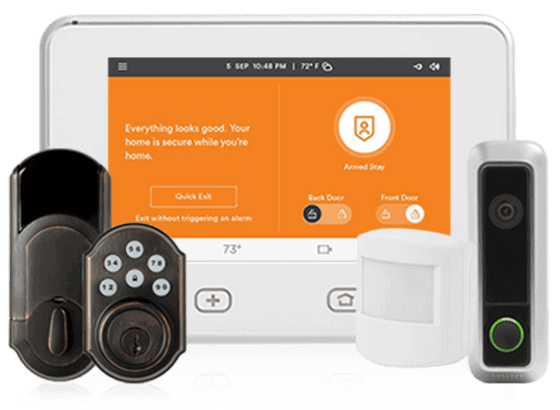
|
Frontpoint


|
Ring Alarm


|
|---|---|---|---|---|---|
| Ranking | 1st | 2nd | 3rd | 4th | 5th |
| Ratings | 9.8/10 | 9.9/10 | 9.4/10 | 8.9/10 | 7.7/10 |
| Outdoor security camera type | Battery-powered; wired with floodlight | Battery-powered with motion-activated spotlight | Plug-in camera with A.I. and optional spotlight attachment | Plug-in camera with 24/7 recording via microSD card | Battery and plug-in options; some with built-in smart lighting |
| Video doorbell type | Battery-powered | Hardwired | Hardwired | Battery-powered | Battery-powered and hardwired options |
| Yard signs and window decals | Yes | Yes | Yes | Yes | Yes |
| Indoor camera | Yes | Yes | Yes | Yes | Yes |
| Safety monitoring (smoke alarms, gas-leak detector, etc.) | Yes | Yes | Yes | Yes | No |
| Professional monitoring | Yes (optional) | Yes (optional) | Yes (required) | Yes (required) | Yes (optional) |
| Self-monitoring | Available with Self Setup systems | Yes | No | No | Yes |
| Installation method | Professional or DIY | Professional or DIY | Professional (required) | DIY | Professional or DIY |
| Read Review | ADT Review | SimpliSafe Review | Vivint Review | Frontpoint Review | Ring Alarm Review |
-
1. ADT - Best in Professional Monitoring
Product Specs
Equipment Costs Packages starting at $269 Monitoring Options Professional and DIY Monthly Monitoring Costs Starting at $24.99 per month Contract Lengths Month-to-month or 36 months and up Installation Options Professional and DIY Smart Platform Integration Alexa and Google Home ADT has appeared on many of our recent home security lists. It topped our roundup of professionally installed security systems and made our list of affordable security systems. It’s also currently our highest-rated option (9.8/10), so it’s no surprise that it’s on this list too. ADT’s biggest advantage is that it’s a great all-around system. It doesn’t excel in just one area, but consistently performs well in terms of equipment, monitoring, and features. It’s one of the best choices both for indoor and outdoor security.
We tested every component ADT offers to get a complete view of how their system works. We used to say that ADT’s pricing carried a premium price tag for premium equipment. But, in a strange twist of events, ADT has been on a streak of slashing its prices. Take the price of the Nest Cams for instance. The outdoor one only costs $179.99. That’s a huge drop compared to the old $309.99 price tag of the ADT outdoor camera. This makes ADT all the more competitive even against budget providers like SimpliSafe who charge $199.99 for their outdoor camera.
To make things better, you can usually offset the cost with deals. ADT offers them from time to time. You might even be able to get a free outdoor camera or doorbell camera if you’re lucky. Plus, if spending hundreds of dollars upfront isn’t ideal and practical, you can always finance your ADT equipment. They let you finance your equipment for up to five years.
>> How to Save: ADT’s Deals and Special Offers
What We Like
- Smart indoor and outdoor cameras
- Battery-powered and security lighting–equipped cameras
- Best-in-class professional monitoring service
- Optional professional installation (with six-month money-back guarantee) ensures the whole system works once installed
What We Don’t Like
- Professional installation isn’t free
- No touchscreen control panel
- Contract required for professionally installed systems
- Regularly changing sales makes it hard to get the best deal
ADT Outdoor Security
Our outdoor security from ADT revolved around two pieces of equipment: the Nest Cam (indoor/outdoor, battery) and the Google Nest Doorbell (battery). You read that right: Some of ADT’s equipment is built by Google Nest. We did separate reviews for both cameras. Here’s our Nest Cam (battery) review and our Nest Doorbell (battery) review. You’ll see how they work as stand-alone devices. They are impressive.
With the Google Nest Cam’s clear footage, we were able to mount it high up while still seeing visitors. Disappointingly, pairing the cameras with ADT unlocked only one additional feature, which was video verification. We’ll talk more about that later, but the Nest cameras don’t need much improvement in the first place. They already have reliable surveillance features; they can detect movement; they can distinguish among people, pets, and vehicles; and they have facial recognition. Pairing them with ADT simply meant we could access those features from ADT’s app rather than Nest’s app.
ADT and Nest offer one other outdoor camera, called the Nest Cam With Floodlight. We didn’t test that one, but it offers features similar to the Nest Cam (battery). Its special distinction is that it has built-in smart floodlights, which can illuminate your home’s exterior and shine the spotlight on intruders.
>> Related: How Do Smart Lights Work?
Professional Monitoring
ADT required us to sign up for professional monitoring since we had our system professionally installed. We ended up paying $49.99 since our system had security cameras. That also unlocked video verification allowing ADT’s monitoring agents to use the live feed of our security cameras to confirm the authenticity of alarms. An Urban Institute study estimates that 90 to 99 percent of alarm calls to the police are false alarms so verifying them speeds up their response.1
We liked ADT’s monitoring service overall. We didn’t mind paying the $49.99 monthly fee, because we felt confident in how fast ADT responds. In our simulated break-ins, ADT always contacted us within 30 seconds of the alarm sounding. We also commend ADT for investing in its monitoring centers. It has twelve — the most of any system we tested — and each facility has backup generators and servers so they can run nonstop.
FYI: ADT also has a nifty feature called Trusted Neighbor. It uses the facial recognition in our Nest Cams to detect trusted people we gave permission to enter our home during certain times or events. That way, during an emergency like a house fire and we’re not home, our neighbor could get into our home and help.
>> More Information: ADT Frequently Asked Questions
Equipment
Our ADT system cost well over $1,000. It’s tough to swallow, but we opted to pay it over 36 months. On top of the monitoring fee, we’re paying $30 per month for equipment. Is it worth it? In a word, yes.
We got a comprehensive indoor security system with security sensors, a couple of smoke alarms, and an indoor camera, plus we know we’re covered outdoors with our Nest Doorbell and Nest Cam (battery). The equipment is high quality. It’s not made of cheap plastic, unlike equipment from budget-friendly ADT alternatives such as Cove. With ADT’s professional installation, you can be almost certain everything will work as intended. If not, ADT will fix it for free or refund your money with a six-month money-back guarantee.
We recommend getting at least one smart display. ADT offers the Nest Hub ($139) and Nest Hub Max ($269). Since ADT’s new system doesn’t have a touch-screen control panel, you’ll need a third-party device like your smartphone or the Google Nest smart displays to view outdoor camera footage. We were a bit disappointed by that because systems like Vivint can display camera footage from the control panel. Fortunately, we still have the one from our Nest Hub Max review.
-
2. SimpliSafe - Best DIY Security System
Product Specs
Equipment Costs Packages starting at $250.96 Monitoring Options Professional and DIY Monthly Monitoring Costs Starts at $21.99 per month Contract Lengths Month-to-month Installation Options DIY or professional Smart Platform Integration Alexa and Google Home SimpliSafe is another one of our go-to security systems. It’s not quite on the same level as ADT yet — it’s a young company with a limited selection of equipment — but we appreciate its flexibility and versatility. It’s one of the best DIY systems, so it’s also a renter-friendly security system. Except for the outdoor camera’s wall mount and the video doorbell’s backplate, we didn’t have to drill anything to install SimpliSafe equipment.
We would have liked to see better features from SimpliSafe though. The 1080p HD resolution from the outdoor and doorbell cameras was fine, but not always crystal clear. The audio was laggy about half the time, and there’s no free video storage. SimpliSafe is a budget brand though. SimpliSafe equipment costs only about half what ADT equipment costs, so the company fits the bill if you’re looking for a more affordable option.
We bought SimpliSafe’s full device lineup to test each of its components. What We Like
- DIY installation in under one hour
- Professional monitoring is optional
- Outdoor camera includes motion-activated spotlight
- Wired doorbell means no need to recharge
What We Don’t Like
- No free video storage (must buy a cloud or monitoring subscription)
- Laggy audio when streaming or using two-way talk
- Must use app or third-party smart display to view live footage
- Limited equipment options
SimpliSafe Outdoor Security
Much like ADT, our SimpliSafe outdoor security hinged on the outdoor and doorbell cameras. We’d like to highlight the doorbell camera in particular. Even though it’s a hardwired doorbell, we managed to set it up in less than 30 minutes. (See our detailed installation experience in our SimpliSafe Video Doorbell Pro review.) All in all, we spent just short of an hour setting up all our SimpliSafe equipment.
We liked the SimpliSafe Outdoor Camera Pro too — so much so that we rated it 8.2 out of 10 in our SimpliSafe outdoor camera review. It has a battery, so you can place it pretty much anywhere. We put ours in our backyard garden to monitor wildlife stealing our cherry tomatoes at night. We found out that it was a raccoon, and, thankfully, the SimpliSafe outdoor camera has built-in motion-activated lights that scared our masked tomato thief away. We imagine it could do the same to actual thieves.
We mounted our SimpliSafe Outdoor Camera next to our garage so we could see cars pulling up our driveway. Professional Monitoring
Our SimpliSafe system came with functions you would expect from a system you can either self-monitor or sign up for professional monitoring. The base station, which is an indoor device that acts as the brain of the system, had a loud 95 dB siren. We could hear it clearly from our garden. We also got a 105 dB auxiliary siren that we placed on our porch, so it would get our neighbors’ attention if we’re not home when a break-in occurs.
We strongly recommend getting professional monitoring though. SimpliSafe is a great self-monitored system, but nothing beats the assurance of having a team of professionals watching your home. We particularly liked SimpliSafe’s Active Guard Outdoor Protection included in the Pro and Pro Plus monitoring plans. It lets SimpliSafe’s monitoring agents access our Outdoor Camera when its AI detection identifies a lurker. Then, they can use the camera’s two-way talk to figure out what the lurker is doing and even chase the trespasser away. On top of that, SimpliSafe agents can remotely trigger our camera’s siren and light as an additional way to spook them off, all while contacting the appropriate authorities.
Did You Know: Similar to SimpliSafe’s Active Guard Outdoor Protection feature, they also offer Intruder Intervention which gives their monitoring agents access to our SimpliSafe Indoor Wireless Cam during alarms. We didn’t need to spring for SimpliSafe’s pricier monitoring plans to get the feature either. It’s included in the $31.99 per month Core plan.
Equipment
We loved our SimpliSafe equipment; we just wish it offered more. SimpliSafe designs its own equipment, and most of it is good quality. Frankly, though, it has been slow to roll out new products. It took the company a couple of years to release an outdoor camera, and then another year to launch a video doorbell.
There are still some pieces of equipment lacking from SimpliSafe. It doesn’t, for example, offer any smart-home products besides a very simplistic smart lock. You won’t be able to find smart lights or smart thermostats either. We loved the battery-powered outdoor camera, but we wish there was a wired option for areas that need more constant monitoring. The same goes for the hardwired video doorbell. We wish there was a battery-powered option for easier installation.
SimpliSafe’s equipment can protect small and midsize homes just fine. It even works for apartments. If you need a more comprehensive system, however, it may not be the best fit.
>> Read More: The Top Apartment Security Systems
-
3. Vivint - Best Outdoor Cameras
Product Specs
Equipment costs Starting at $599 Monitoring options Professional Monthly monitoring costs Starting from $30 per month Contract lengths Starting at 42 months Installation options Professional Smart platform integration Alexa and Google Home We like Vivint because it’s smart. It offers well-thought-out features that most security systems we’ve tested don’t, especially when it comes to home automation and security cameras. That’s why Vivint is easily one of the best security systems for smart homes.
Our Vivint Base Hub offered us a lot of functionality so we mounted it conveniently in our living room. In our testing, we were able to set our outdoor camera and video doorbell to start recording as soon as our indoor sensors detect any movement. That way, we could see a full picture of the incident if someone broke in. You’d think that would be a common feature, but Vivint is one of the few systems to offer it.
Our Vivint system worked great, but fair warning: It wasn’t cheap. We could have spent over $2,000 if we weren’t careful adding equipment. The outdoor camera alone costs $400 — we almost bought two — and the video doorbell costs $250. We blame Vivint’s lack of transparency. If Vivint’s prices were displayed online like SimpliSafe’s, we would have been able to plan our budget better.
What We Like
- Feature-rich system with lots of automation options
- Top-notch equipment quality and features
- Outdoor cameras have smart deterrence
- Professional installation ensured proper setup
What We Don’t Like
- Lack of pricing transparency
- Expensive security cameras
- Requires a long-term contract (up to five years)
- Professional installation can cost up to $200
Vivint Outdoor Security
We talked about Vivint’s unique ability to detect trespassers in our Vivint Outdoor Camera Pro review. It detects lurkers and prowlers even if they don’t actually approach your house. It uses artificial intelligence to distinguish human movement, and then applies the rules you set to know when to sound the Deter alarm. The Deter alarm, by the way, includes flashing red lights around the camera’s lens and a customizable alert tone. Our rule for our Outdoor Camera Pro looked something like this: If someone steps into our detection zone and stays for more than 10 seconds, set off the Deter alarm and play a whistle tone.
Our Vivint Outdoor Camera Pro (Gen 2) used AI detection and its built-in siren to deter criminals in the act. We made our Vivint camera even better with the Spotlight Pro attachment, which we bought for another $250. It essentially turned our Outdoor Camera Pro into a spotlight camera, but it also used the camera’s AI to focus its light on potential trespassers. We tried walking around our front yard with the spotlight on, and it followed us around as though we were actors in a play. We wouldn’t say it’s perfect — it lagged behind when we paced a little faster — but it was pretty good.
>> Learn About: Can Security Cameras Deter Burglars?
Professional Monitoring
Unlike SimpliSafe that can monitor your security cameras for you, Vivint doesn’t include cameras in its professional monitoring, so the Deter alarm is all you’ll get if there’s ever a trespasser. Everything else was monitored by Vivint’s two U.S.-based monitoring centers. It doesn’t have as many monitoring facilities as ADT, but two is still better than one — or none.
In our experience, Vivint’s monitoring provides exactly what’s needed for indoor and outdoor security. The few times we simulated break-ins with Vivint, we were on the line with an agent in about 30 seconds. What’s more, we didn’t need to use our phones. We talked to them via the control panel itself, another rarely seen feature in home security. We remember having access to the same functionality in our Alder review.
Vivint didn’t have the best monitoring features — that goes to ADT — but it was a close second. For the $49 per month we paid for the service, we think we got our money’s worth.
FYI: When we signed our monitoring contract, we realized there was only a 72-hour money-back guarantee. That’s shorter than we’re used to with most providers offering at least a 30-day money-back guarantee.
Equipment
Unlike its monitoring service, Vivint’s equipment is really solid. The build quality is great and the features are cutting edge. Unlike with our ADT system, we didn’t need to use a separate smart display because the control panel itself was able to show us live and recorded videos. Not to mention, we enjoyed continuous protection even through power and internet outages, thanks to the panel’s battery backup and cellular connectivity.
If we were to nitpick, the area that needs improvement is the design. Vivint’s sensors aren’t ugly, but they are bulkier and boxier than we prefer, especially from a smart security system like Vivint. In hindsight, we should have gotten the slightly pricier recessed door sensor. That would have been easier to hide than the plain white Vivint door sensor that’s currently on our brown, wooden front door. It just stands out too much.
-
4. Frontpoint - Best Outdoor Cameras with 24/7 Recording
Product Specs
Equipment Costs Starting at $69.00 Monitoring Options Professional only Monthly Monitoring Costs Starting at $14.99 Contract Lengths 1-36 months Installation Options DIY Smart Platform Integration Alexa and Google Home Frontpoint is a good Vivint alternative if you’re looking for affordable, high-quality equipment with strong automation capabilities. Frontpoint’s outdoor camera even has a feature similar to Vivint’s Smart Deterrence.
Stepping out of Vivint’s shadow, though, Frontpoint offers flexibility as a DIY system. It was super easy to install too. We set up all the indoor equipment in less than 30 minutes, and the outdoor components in another half-hour. We bought two outdoor cameras and one of Frontpoint’s battery-powered doorbells from Alarm.com. Even though it’s a DIY system, we got a lot of help from Frontpoint’s FAQ section and knowledge base, as well as its friendly phone support.
We opted to buy the extra touchscreen controller for our Frontpoint security system although it’s not required. What We Like
- Affordable equipment with frequent deals and discounts
- All wireless equipment (except some plug-in cameras)
- Outdoor cameras capable of continuous recording
- Outdoor cameras offer active crime deterrence
What We Don’t Like
- Requires professional monitoring and a contract
- Control panel (hub) has no screen
- Video quality drops off occasionally
- Limited Wi-Fi range (49 feet)
Frontpoint Outdoor Security
We were impressed by the Frontpoint outdoor camera. It costs about half what the Vivint Outdoor Camera Pro costs, but it offers AI-powered video analytics to enable Smart Deterrence–like functionalities. Its built-in lights activate and it rings a loud alarm when a person or animal enters your set perimeter.
We also liked that the Frontpoint outdoor camera can store 24/7 rolling videos — a.k.a. continuous recording. All the other cameras on this list record only motion events, so Frontpoint is unique. We usually see continuous recording only in cameras with DVR, like the Lorex camera system we reviewed. Those cameras require a more tedious installation, because they have to be connected to a computer box (DVR). No such setup was required with Frontpoint. The outdoor camera stored videos on a microSD card. We simply plugged in the card after mounting the camera, and it started rolling.
Pro Tip: We don’t recommend relying only on a microSD card in your security camera for storing your footage. Burglars can easily snatch the camera on their way out taking all video evidence of the crime with them. Thankfully, Frontpoint offers cloud backup for motion events to keep this evidence secure.
Monitoring
Frontpoint, like ADT and Vivint, requires professional monitoring, and we have mixed opinions on it. For starters, Frontpoint offers only one main option, and it costs $49.99 per month. You’ll pay the same price even if you have a basic security system with just sensors and no cameras. Monitoring for a system like that costs $24.99 with ADT and $29.99 with Vivint. You can get monitoring for as low as $14.99 per month with Frontpoint but it requires calling them. Given that they want their customers to buy their system online, we’re not a big fan of them hiding their economical monitoring plans behind a phone call.
If you’re looking to add outdoor security — which means outdoor cameras and a video doorbell — Frontpoint’s pricing is competitive. ADT and Vivint both charge the same prices, although admittedly, there are cheaper options like SimpliSafe and Cove.
Frontpoint’s quality of service, however, excelled. Response times were quick — around 45 seconds — and we got a 30-day video history from our indoor and outdoor cameras. The event history was stored in the cloud to supplement the continuous recording feature.
Equipment
Our Frontpoint outdoor camera came with an outdoor power cable we could use instead of the battery. We have mixed feelings about Frontpoint’s equipment too. On one hand, it feels sturdy and well built. We accidentally dropped the keypad while installing it, and it barely had any scratches and still worked perfectly. The outdoor cameras have a good heft to them. They have an IP66 rating, so we didn’t worry about keeping them outside while it rained. Our one gripe is their limited viewing angle (117 degrees). One wasn’t enough to watch our entire front yard, so we bought two. Overall, though, we loved the quality.
On the other hand, Frontpoint’s equipment is a little on the expensive side compared to other DIY systems like SimpliSafe. SimpliSafe’s motion sensor costs $35, but the same sensor costs $70 with Frontpoint. Fortunately, you can take advantage of Frontpoint’s deals to offset the equipment cost. There was a 50 percent off deal at the time we purchased our system, so we essentially got the Frontpoint motion sensor for the same price as SimpliSafe’s.
-
5. Ring Alarm - Best Video Doorbells and Lighting-Equipped Cameras
View on Amazon Links to Amazon.comProduct Specs
Equipment Costs Packages starting at $244.95 Monitoring Options Professional and DIY Monthly Monitoring Costs $10 with the purchase of a Ring Home plan Contract Lengths 1-12 months Installation Options DIY or professional Smart Platform Integration Alexa and Google Home We’ve said from the start that outdoor cameras and video doorbells are the key to outdoor home security, and Ring has about the biggest selection for both. It offers four types of outdoor cameras, and each comes in a plug-in, wired, solar-powered, or battery-powered version. Two models — the Ring Floodlight Cam and the Ring Spotlight Cam we reviewed — offer built-in security lighting.
Outdoor cameras aside, Ring’s video doorbell lineup consists of battery-powered and hardwired options. We’ve reviewed the Ring Wired Doorbell Plus, one of Ring’s more expensive doorbells. We’ve also tested the Ring Video Doorbell 3, one of the cheaper ones in the lineup, but it’s since been discontinued. Now, we recommend the Ring Battery Doorbell for a budget, battery-powered alternative. No matter the price point, Ring’s doorbells provide good outdoor security.
We lined up our Ring Alarm System to give a clear look at their aesthetic and relative size. What We Like
- Lots of outdoor and doorbell camera options
- Outdoor cameras equipped with security light
- Affordable cloud and monitoring subscriptions
- Good equipment quality with video doorbells and cameras
What We Don’t Like
- Limited options for indoor security
- Only one indoor camera available
- Lacks local video storage
- Internet-reliant cameras and system
Ring Outdoor Security
With an outdoor camera lineup as huge as Ring’s, we had no problem finding a camera for our front yard and backyard. The Spotlight Cam Plus Battery is just the right fit for us, because it’s battery-powered; it has a bright, motion-activated spotlight (solved our raccoon problem like the SimpliSafe Outdoor Camera Pro); and it offers motion and privacy zones, which means we can zone in its motion sensors to avoid false alarms. With our battery-powered Ring Battery Doorbell Pro, we surrounded our home with cameras for full outdoor security.
We also noticed that Ring has an outdoor contact sensor — the only system we tested with such a device. The outdoor contact sensor is basically a door sensor rated for outdoor use. We didn’t get one, but we imagine it would be useful for homes with an outdoor shed or any other outbuildings, as well as gated homes. To use it, though, you’d need to buy a Ring Alarm or Ring Alarm Pro, Ring’s indoor security systems.
Did You Know: That same Spotlight Cam Plus Battery also has a solar-powered option. It costs $60 more but that means you’ll never need to worry about charging the battery. We didn’t find it was worth it, but it might be for you.
Monitoring
Ring recently revamped its DIY and professional monitoring plans. They now offer three tiers of Ring Home which is their cloud storage and advanced feature plans, with the option to add professional monitoring on mid-tier or top-tier Ring Home plans. That still keeps their $20 per month professional monitoring plan ($9.99 for the mid-tier Standard plan + $10 for the professional monitoring add-on). We love that price point because it also includes cloud storage for any number of Ring cameras. Recordings will stay in the cloud for up to 180 days.
On the downside, we didn’t love Ring’s lack of video verification. That seems like a missed opportunity, considering Ring offers a wide selection of cameras. They’d certainly be handy in verifying alarms. There is the Virtual Security Guard add-on that includes Live Video Monitoring but it’s expensive at an additional $99 per month plus the cloud storage plan. All in, that could bring your monthly bill up to $128.99 per month.
>> Compare: Ring Alarm vs. SimpliSafe
Equipment
We recommend starting with Ring’s outdoor security cameras. We bought two Spotlight Cam Batteries and a Ring Video Doorbell Pro, but you can mix and match any available camera from Ring. They all work together via Ring’s smartphone app, where we watched live videos and played back recorded clips.
Our Ring Spotlight Cam Pro looked like a beacon of safety with its light on during a snowstorm. We also recommend pairing Ring’s indoor and outdoor cameras with a security system. The ideal choice is the Ring Alarm, which can consist of entry sensors, motion sensors, a hub, and a keypad. You can also get smoke alarms that work with the system from First Alert.
Is the Ring Alarm the perfect choice for security? We’re not sure. It’s a bare-bones security system. We liked it as a partner for Ring cameras because it works with the same app, but you can use a different indoor security system if you like. The Ring cameras can work on their own, with or without a Ring alarm.
>> More Options: The Best Security Systems With An App
Outdoor Security Placement Tips
The right equipment is only part of what you need for outdoor security. You also need to know how to best use the devices to improve your outdoor security and overall home security. The key is knowing where to place your security cameras for maximum coverage, so let’s talk about that.
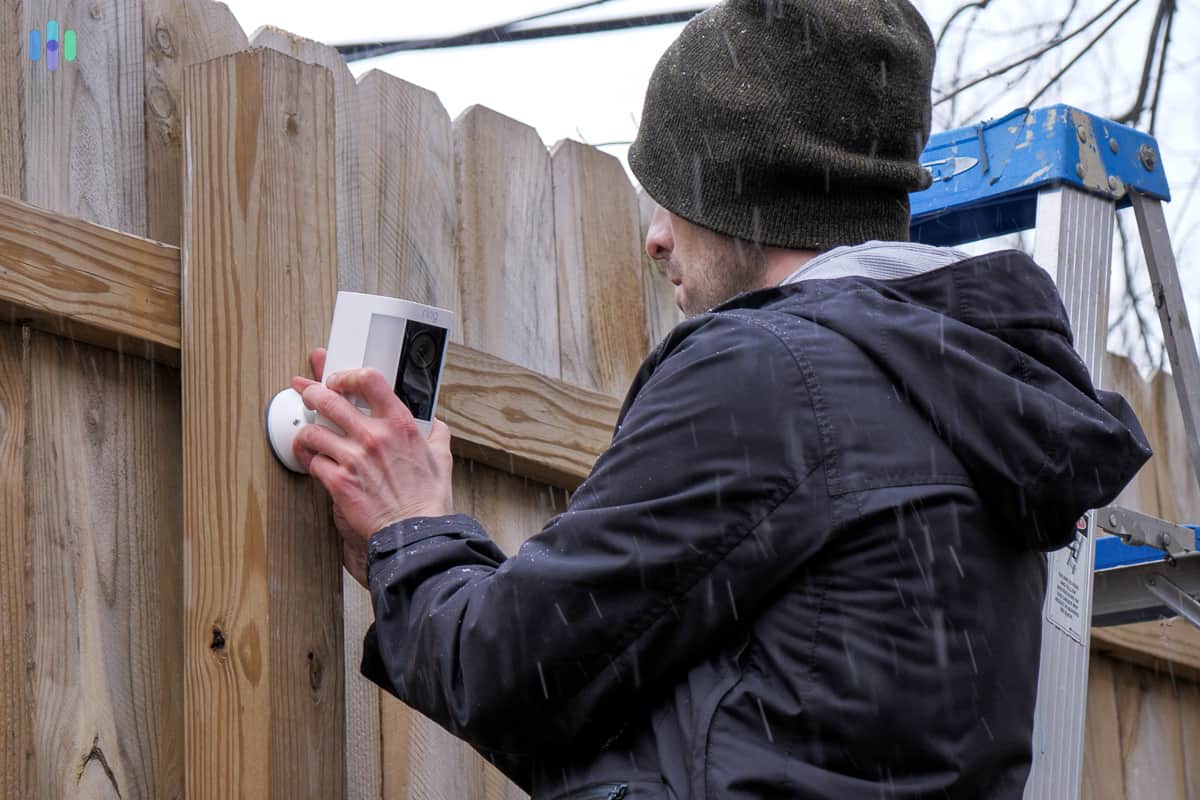
For Professionally Installed Systems
Two of our top picks, ADT and Vivint, require professional installation. A technician will do all the work for you, so you can just sit back and relax. You can trust their judgment most times, but, if you want to be sure, you can follow them around and ask why they picked a specific spot for a device. You can also offer suggestions, but keep in mind that they’re the experts.
For DIY Systems
If you’re doing the installation yourself, you have to consider a lot of things when picking spots for your outdoor cameras. Generally, we recommend placing your cameras:
- High, between 8 and 10 feet off the ground so they get a better vantage point.
- Away from direct sunlight and artificial lighting to avoid glare in the videos.
- Pointed at entry points such as pathways and driveways to monitor who comes and goes.
You should also consider whether you want to hide your cameras or keep them exposed. Exposed outdoor cameras may deter some intruders, but they are also more likely to be vandalized. Hiding your outdoor cameras, on the other hand, gives you a better chance of catching trespassers in the act, but they do nothing to prevent or deter crime. We recommend having both exposed and hidden cameras.
Lastly, don’t forget to test your cameras’ fields of vision. All our top-pick systems offer a smartphone app through which you can monitor your cameras’ live footage. Test the limits of their peripheral vision and make necessary adjustments to eliminate blind spots.
>> Further Reading: Can Security Cameras Work Without Wi-Fi?
Do Yard Signs and Window Stickers Work?

Besides offering outdoor cameras, another thing our top picks have in common is that they all offer yard signs and window decals. You can place them around your property to show your home is under protection — at least in theory. Does it actually work though?
A study conducted by the University of North Carolina, Charlotte, Department of Criminal Justice and Criminology suggests that it does. Nearly two-thirds of career burglars say they try to avoid homes that clearly have security equipment.2 Having yard signs and window stickers plastered around your property is a good indicator that you have a working security system, especially if you visibly have security cameras.
That said, use yard signs and stickers only from a real alarm company. You can buy fake yard signs and even fake security cameras on the internet, but they do nothing to protect you. They may even invite trouble. Seasoned burglars can easily spot fake equipment, which may clue them in that you don’t have a real security system in place. Rather than fake yard signs and cameras, buy affordable security cameras instead.
Do All Homes Need an Outdoor Security System?

No matter how big or small your outdoor space is, you need outdoor security to keep burglars out. Even if you live in an apartment complex where you don’t have your own outdoor space, you can still benefit from an outdoor security system. What changes is the amount of equipment you need.
A rural home on a multiacre property, for example, will need different equipment than a house in the suburbs with a standard front yard and driveway. Check out our roundup of the best rural home security systems for ideas on how to protect a sprawling property. What about apartments? You may need just one type of equipment: a video doorbell. That way, you can monitor whenever someone stops at your door.
The point of outdoor security is to stop criminals before they can enter your home, so an outdoor security system is necessary.
Recap: The Best Security Systems for Outdoor Protection
ADT, SimpliSafe, Vivint, Frontpoint, and Ring offer the best security systems to protect your outdoor space. All five offer outdoor cameras and video doorbells, and most have unique features such as person detection, facial recognition, continuous recording, and smart deterrence.
We strongly recommend choosing the best option for your home based on the overall performance of the security systems. Keep in mind how they protect your outdoor space, but also consider how well they can protect the inside of your house. For that, you have to look at their equipment and monitoring options.
Any of those systems is a good option. To pick the best security system specifically for your home, though, see our guide on how to secure your home.
FAQs
-
What are the best outdoor security cameras?
The best outdoor security cameras offer motion detection backed by AI (person detection, package detection, facial recognition, etc.), video recording, and live streaming. We saw cameras with those features from our top outdoor security systems — namely ADT, SimpliSafe, Vivint, Frontpoint, and Ring. The best outdoor camera for your home, however, depends on your property’s layout. We recommend assessing your home’s risk factors and then choosing a brand that offers security cameras that can solve those issues.
-
Can outdoor cameras work without Wi-Fi?
Some of them can. Arlo and Reolink, for example, have cameras that can stream videos via 4G/LTE or 5G signals. Most cameras need Wi-Fi though. If your Wi-Fi doesn’t reach outside, consider using wired or PoE cameras.
-
Are outdoor security cameras difficult to install?
That depends on your placement and the type of camera you’re using. Some need to be plugged into a power outlet, while others can use batteries or even solar power. Some also require running wires to a recording box indoors. Wireless cameras are the easiest to install, while wired ones typically require more work.
-
What do video doorbells do?
Video doorbells provide video monitoring for your front door. They replace a traditional doorbell to offer functionalities such as two-way talk and live video streaming so you can see and hear your guests.
-
Do fake security cameras work?
No, fake security cameras don’t work. They may be able to fool some burglars, but fake cameras are easy to spot. Rather than fake outdoor cameras, buy affordable security cameras from brands such as Ring, Wyze, or Blink.
-
Urban Institute. (2012). OPPORTUNITIES FOR POLICE COST SAVINGS WITHOUT SACRIFICING SERVICE QUALITY: REDUCING FALSE ALARMS.
urban.org/sites/default/files/publication/23221/412729-opportunities-for-police-cost-savings-without-sacrificing-service-quality-reducing-false-alarms.pdf -
Kuhns, Joseph. (2012). Understanding Decisions to Burglarize from the Offender's Perspective.
researchgate.net/publication/268444817_Understanding_Decisions_to_Burglarize_from_the_Offender's_Perspective/citation/download




